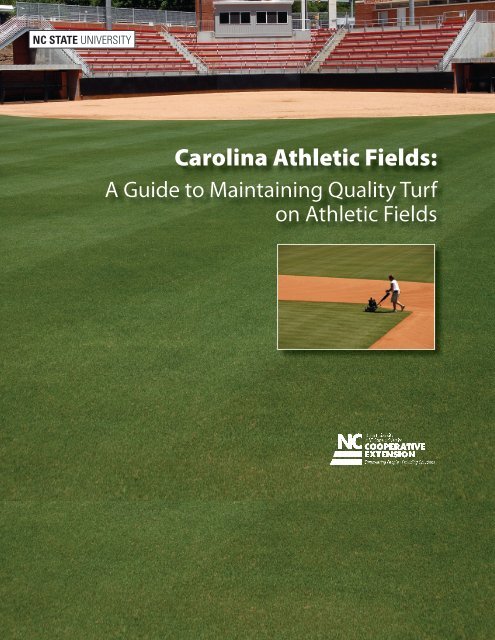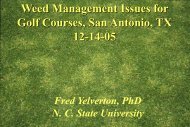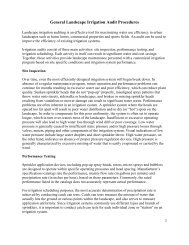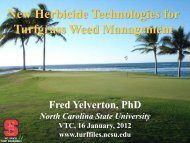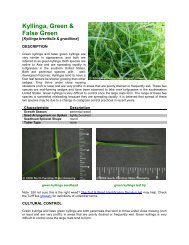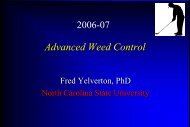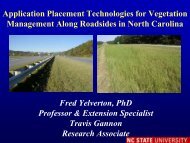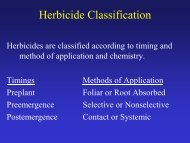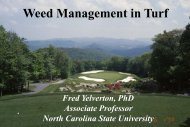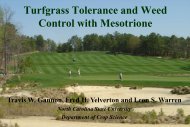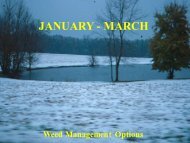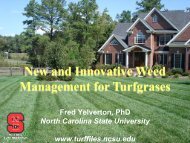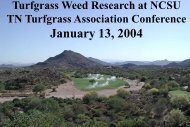Carolina Athletic Fields: - TurfFiles - North Carolina State University
Carolina Athletic Fields: - TurfFiles - North Carolina State University
Carolina Athletic Fields: - TurfFiles - North Carolina State University
- No tags were found...
You also want an ePaper? Increase the reach of your titles
YUMPU automatically turns print PDFs into web optimized ePapers that Google loves.
NC STATE UNIVERSITY<strong>Carolina</strong> <strong>Athletic</strong> <strong>Fields</strong>:A Guide to Maintaining Quality Turfon <strong>Athletic</strong> <strong>Fields</strong>
INTRODUCTIONSports fields play a pivotal role in recreational andcompetitive outdoor athletic activities. A quality playingsurface is appreciated by all participants, whether playingcasual pick-up games or professional team sports,and produces a pleasing appearance to spectators. Inaddition, sports complexes are facing increasing legalquestions and liability regarding injuries associated witha poorly designed, constructed, or maintained facility. Tohave a quality turfgrass playing surface in all seasons ofuse, sports fields must have the following:(1) Adequate surface and subsurface water drainage.(2) A properly designed, installed, and maintainedirrigation system.(3) A vigorous, regular turfgrass maintenance programwith an appropriate turfgrass.(4) Reasonable play and field use.(5) Basic equipment.An unacceptable turfgrass stand often results whenone or more of these elements are omitted or whenuncontrolled or excessive play and traffic are allowed.Bermudagrass exhibits optimum growth during summermonths; however, with the onset of play and traffic in fall,along with soil compaction, the turf may become excessivelyworn. For this reason, some fields will be overseededwith a ryegrass to provide a wearable surface duringthe winter and early spring seasons.FIELD DIMENSIONSThe first step in developing a turfgrass management planis to understand the areas that make up the field. Thesefigures are needed to budget for items such as appropriatetime and amount of product to be applied. Certainsports place heavy traffic on specific areas of the field.Soccer fields are heavily worn at the goal areas, whereasfootball tends to be played between the hash marks andthe 20-yard lines. Baseball and softball are played mostlyon skinned areas. A comparison of athletic field dimensionsand relative field sizes is listed in Table 1.FIELD USE CAPACITYA common question relates to how much play a field canwithstand. Every effort should be made to accommodateall participating groups, but not at the expense of thefields. Information related to field use parameters can befound in extension publication AG-726 Maximizing theDurability of <strong>Athletic</strong> <strong>Fields</strong>.Softball field includes turf as well as clay surface.ATHLETIC FIELD DESIGNBefore construction, prepare a realistic timetable for everyoperation, from writing specifications and contractor bidsto field completion. Most people unacquainted with thework involved are surprised at the length of time neededto complete the planning and construction of a field—anywhere from a couple of months to two years, dependingon project size, contractor experience, and weather.All athletic fields should be designed and constructedto meet standard dimensions of the game for which theywill be used. Contours and drainage provisions are veryimportant, as these provide for fast removal of surfacewater to maintain desirable playing conditions. If possible,orient fields to minimize time that players must lookdirectly into the sun during games. Generally, the longaxis of the field should be in a north-south direction,which also minimizes the field area shaded during thewinter months if there are trees along the south side ofthe field. A good design will provide an adequate irrigationsystem, drainage, and proper orientation of the field.High-capacity football fields are constructed with a sand baseto have good internal drainage. Proper construction withdrain lines allows for a flatter field.3
<strong>Carolina</strong> <strong>Athletic</strong> <strong>Fields</strong>: A Guide to Maintaining Quality Turf on <strong>Athletic</strong> <strong>Fields</strong>Table 1. Field dimensions and sizes of various sports fields.Sport Dimensions (Feet) Area General CommentsFootball360L by 160W57,600 square feet (or1.3 acres)This 1.3 acres is within the sidelines. Outside the sidelines is typically 20or more feet or 30,000 square feet of space. Together these two areascomprise approximately 2 acres. Primary play is between the hash markswhich comprise about 20,000 square feet.Baseball90 betweenbases110,00 square feet (or2.5 acres total) withapproximately 11,500square feet of skinnedinfieldBaseball fields vary in size depending on the depth of the fences (300feet minimum fair line to 400 feet to center). A minimum of 12 feet inthe outfield and 8 feet around the stands is used for the warning track.Professional fields are usually 15 feet in the outfield and 12 to 15 feet infoul territory. The infield receives heaviest play. (Note: Little League, PonyLeague, and Babe Ruth League have smaller dimensions than listed). Seepublication AG-725 Baseball Field Layout & Construction.Soccer360L by 225W81,000 square feet (or1.9 acres)Soccer fields contain an average of 78,000 square feet with an additionalarea of 8,000 to 10,000 square feet along the sidelines, which receiveheavy traffic. A soccer field is larger than a football field, mostly in width,but soccer has many dimensions, depending on the age of the participants.Goal mouths, center field, referee sidelines, and the four cornerkick areas have highest wear.Softball65 betweenbases40,000 to 70,000square feetSlow pitch softball has an average fence depth of 300 feet and approximately70,000 square feet of turf, depending on the sideline areas. Fastpitch softball fields have an average depth of 200 feet and approximately40,000 square feet of turf, depending on the sideline area. The 3 outfielderpositions have most of the turf wear.What to PlantIt is best to consult with a state turf specialist or anestablished field construction contractor to discuss grassoptions. No one type of grass is best suited to all situations.A number of factors should be considered beforedeciding which grass to plant. Your decision should bebased on region, climate, intended use or wear at the site,and desired appearance. For the most part, NC fieldsare grassed with a bermudagrass. There are some exceptionsin the mountains, but even in much of western NC,bermudagrass is often used on fields.Bermudagrass is desirable for athletic fields becauseit establishes quickly, withstands wear and traffic, andrecovers rapidly from injury. Bermudagrass is extremelydrought tolerant, grows rapidly on most soil types, andmakes a good turf surface if fertilized and mowed lowand often. Cultivar texture ranges from coarse to fine,and it forms a dense, durable surface when grown in fullsunlight.Most finely textured, high-quality turf-type bermudagrassesare planted using sod, sprigs, or plugs. Commonbermudagrass, which is the most coarsely textured, can beseeded. Several newer cultivars that have a medium texturecan also be seeded. Bermudagrass should be seeded at 1 to2 pounds per 1,000 square feet (45 to 90 pounds per acre).Currently, the best and most often used hybrid bermudagrassfor sports fields is Tifway (also called Tifton419). Other improved bermudagrasses sometimes foundon athletic fields include TifSport, Patriot, Celebration,GN-1, and Tifton 10. These grasses must be establishedvegetatively, most commonly by sprigs and less so byplugs or sod. The initial cost of these planting methodsis greater than seeding common bermudagrass; however,for the desired aesthetics, color, density, texture,and recuperative potential, these improved cultivars aresuperior to common bermudagrass.Seeded bermudagrasses (common bermudagrass) areused primarily because they can be established by seed,which is relatively inexpensive. However, one shouldrecognize that compared to Tifway bermudagrass, mostseeded bermudagrasses produce a lower quality surfacedue to their lighter green color, coarser leaf blades anddensity, unsightly stem and seedhead production duringsummer, and slower recuperative potential. Princess 77and Riviera are two cultivars that can be seeded and areof high quality, similar to the best vegetatively establishedcultivars. Riviera is also known for its excellent cold tolerance,as is the coarser textured Yukon.Other improved common bermudagrasses that havebetter color and density compared to the old Arizona4
common bermudagrass include: Blackjack, Blue-Muda,Bradley, Burning Tree, Cheyenne, DelSol, Guymon,Jackpot, LaPaloma, LaPrima (a blend of certified bermudagrasses),Majestic, Mercury, Mirage, Mohawk, Panama,Paradise, Primavera, Primo, Pyramid, Sahara, Savannah,Shangri-La, Soliel, Sonesta, Southern Star, SR 9554,Sultan, Sundance II, Sundevil II, SunStar, Sultan, Sydney,Transcontinental, Yukon, and Yuma.Winter-Kill ConsiderationsFor those sports fields located in the upper piedmontand mountainous regions that are prone to winter lowtemperatureinjury, the choices for bermudagrass becomemore of an issue of survival rather than aesthetics.Midlawn, Midfield, Midiron, Patriot, Quickstand, andVamont are vegetatively propagated bermudagrass selectionswith increased cold tolerance primarily due to theirdeeper and more robust rhizomes. These selections alsotend to retain color longer in fall and green-up sooner inspring, and they are more vigorous in their growth andrecovery from damage or winter-kill. Yukon and Rivieraare seeded bermudagrasses with improved cold toleranceand playing characteristics. In addition, winter-killconsiderations determine which preemergence herbicideto use for crabgrass and goosegrass control. (See weedcontrol section for further details.)Field DrainageReasonable water drainage from a field is important tominimize event cancellations as well as to protect theintegrity of the field. <strong>Fields</strong> built with heavy native soilsdepend primarily on surface drainage to remove excesswater. These fields hold nutrients and have a high waterholdingcapacity, thus, require less fertilizer and water.They also provide good stability, shear strength, and traction.On the downside, most provide inadequate drainageand may compact easily. Perimeter drain lines areneeded to move surface run-off.Sand-based fields can be built essentially flat,not heavily crowned, and have high infiltration rates.Their internal drainage may be designed to move largeamounts of water away quickly. They have minimumcompaction but require more irrigation and fertilizationthan native soils, are usually more expensive to build, andmay be unstable until a mature root zone is established.Minimum Drainage RequirementsFor many high school and local municipal fields, surfacecontouring is the most effective and economical means ofproviding surface drainage. If insufficient sloping of thesurface occurs, water will stand (puddle), saturating thesoil, and the field can be easily compacted and damagedA smaller laser-guided dozer used to spread soil mix. Noteuse of silt fence and plywood to protect sub-surface layers.by traffic. To provide surface drainage, high school footballfields should have a 12-inch crown for sandy soilsand 18 inches for clay soils from center to the sidelineor a 1 to 2 percent slope. Slope at the sideline may bereduced, but the area should not be flat. Surface watermovement in the areas where players stand is importantto prevent puddling.A minimum of four drainage tile lines should beinstalled, one running parallel to the center crown, typicallydown each hash mark, and the other set just off thefield along each sideline. Drain lines are usually 6 incheswide and 12 to 36 inches deep. Two inches of gravel isplaced at the bottom of the lines, a 4-inch perforateddrain line laid on top of this gravel layer, and pea gravel(¼ to ½ inch) or coarse sand is used to fill the trench tograde. The tile should not be laid within 4 inches of thesurface to prevent disruption from future aerifications.The tiles are laid on a continued ½ to 1 percent slope andare connected at their ends to allow water to drain awayfrom the field. Surface catch basins (or culverts) shouldalso be installed between the playing field and both sidelines(stands). These intercept surface drainage from thefield as well as water draining from the spectator stands.At least three (preferably four or more) catch basinsshould be considered for each side of the field. Similardrainage schemes can be developed for soccer, baseball,or other types of sports fields. It is suggested that acontractor be consulted before constructing a baseballfield due to the complexity of removing water from theinfields without flooding dugout areas.ESTABLISHING A NEW FIELDSite PreparationProper preparation prior to planting is critical to ensurethe establishment of a quality turf. Preparation will determinehow quickly the grass becomes established andits long-term maintenance requirements. Soil should be5
<strong>Carolina</strong> <strong>Athletic</strong> <strong>Fields</strong>: A Guide to Maintaining Quality Turf on <strong>Athletic</strong> <strong>Fields</strong>Installation of turfgrass sod on football field.prepared whether you are planting a new field or replantingan old one, and whether you are seeding or propagatingvegetatively. The following steps provide a generalguideline for preparing an area for planting a sports field.1. Clean and Rough Grade. Remove all constructiondebris, brush, large roots, rocks, weeds, and oldtree stumps. If extensive grading is needed, removethe topsoil and stockpile it for replacement afterthe rough grade is established. The site should becrowned 1 to 2 percent (½- to 1-foot fall per 50 feet)toward the sidelines. The rough grade should conformto the final grade after the topsoil is replaced.Poorly-drained soil may require the installation ofdrainage lines. Install them in a trench with at least a1 percent fall for drainage. Seek professional adviceif uncertain about the type and installation procedure.Perennial weeds should be controlled duringsite preparation. Several applications of a nonselectiveherbicide such as glyphosate (Roundup Pro) plusfluazifop (Fusilade II) may be necessary for completeweed control. Hard-to-control weeds may require theservices of a professional.2. Soil Analysis. A soil analysis should be taken beforeplanting. A representative soil sample can be submittedto NCDA Soil Testing service or to a private lab.A soil test will determine the pH value, and the reportwill indicate whether pH adjustment is necessary. Thedesired range of soil pH for bermudagrass is 6.0 to6.5. Values below 5.0 and above 7.0 can restrict rootingand specific nutrient availability. If the soil is tooacidic (pH too low), dolomitic limestone (dolomite)is recommended for increasing soil pH. Applicationshould be based on a lime requirement that considersboth soil buffering capacity and soil pH value. Inlieu of a lime requirement analysis, the applicationof 1 ton of dolomite per acre or 50 pounds per 1,000Clay areas of baseball fields require proper grading in relationto the turfgrass surfaces.square feet is sufficient to increase the pH of mostsandy soils one pH unit—for example, from pH 5.0to 6.0. For clay soils, 100 pounds per 1,000 square feetmay be necessary. Turf grown on alkaline soils (pHlevels greater than 7.0) often displays deficiencies inminor nutrients such as iron and manganese. Furtherdetails on soil pH adjustment can be obtained fromthe Cooperative Extension Service in your county.Based on soil test analysis, fertilizer should be appliedto correct nutrient level deficiencies in the soil.If phosphorus is deficient, a fertilizer high in phosphorus(such as 0–20–0) should be added prior toplanting. Potassium also should be added, if needed,prior to planting. A starter fertilizer (fertilizer withhigher P content than the other nutrients) shouldbe used at the time of establishment with vegetativeplantings, but delayed until after germination if thearea is seeded. Apply a fertilizer based primarily onsoil test results and local product availability. A generalrecommendation is to use a turf-type fertilizer in4:1:2 or 3:1:2 ratios with micronutrients. Apply at arate of 1 pound soluble nitrogen per 1,000 square feet.3. Installation of Irrigation Equipment. The irrigationsystem should be designed by an irrigation specialistand installed according to design specifications. Apoorly designed or improperly installed system willnever operate satisfactorily. Operation must be in amanner consistent with sound principles of turfgrassculture.Clay soilsFor heavy clay soils, sand can be added to improve physicalproperties. However, enormous amounts are typicallynecessary for a positive response. Typically, in a piedmontclay soil, up to 90 percent sand is required to make6
<strong>Carolina</strong> <strong>Athletic</strong> <strong>Fields</strong>: A Guide to Maintaining Quality Turf on <strong>Athletic</strong> <strong>Fields</strong>initially and can introduce different soil types or pestssuch as nematodes, weeds, or fire ants, from the harvestedfield into the root zone. As a minimum specification,sodding should be utilized for areas prone to soil erosion,such as steep slopes and areas surrounding culverts andirrigation heads.Before installing sod, the seedbed should be watered.The sod should be installed soon, preferably within 48hours, after harvest. Edges of the sod should butt againsteach other tightly without stretching. Avoid gaps or overlapsby using machetes or sharp knives to trim aroundcorners and edges. Joints between the sod should bestaggered in a brick-like fashion so none of the edges ofadjacent pieces of sod are parallel. After installation, thesod should be rolled to ensure evenness and smoothnessand immediately watered heavily to wet the entire depthof the sod and top portion of the rootzone. Topdressingshould be implemented to fill in creases and low piecesand to help conserve moisture. Although sodding producesan almost instant green turf, it should be allowedto knit-down (or root) before subject to traffic and play.Four weeks is generally the minimum time necessaryfor this during periods of active turfgrass growth, longerwhen the turfgrass is not actively growing. One shouldnot be able to lift the sod if it is fully rooted.CARING FOR A NEW FIELDIrrigationProper water management is critical for the first severalweeks after turfgrass planting. To prevent dryingof planting material, keep the top 1.5 inches of the soilmoist. This may require light watering two or three timesa day for 7 to 30 days. As the seedlings grow and root,water less often but for longer periods. Do not makethe mistake of decreasing water as soon as the seedlingsappear. Continue watering until the seedlings emerge.After the third mowing, water to a depth of 6 to 8 inchesabout once a week or when needed. Turfgrass establishmentfrom sprigging, stolonizing, or plugging requiresconstant moisture due to the lack of soil associated withthese vegetative materials. In contrast, sod requires theleast amount of water because soil associated with sodprovides some moisture. Irrigation or watering shouldcontinue on a frequent basis to maintain a moist soilsurface for the vegetative plantings. Frequent surfaceirrigation should be continued for a two- to three-weekperiod or until establishment occurs.FertilizationProper fertilization is essential for plant growth anddevelopment after seed germination. Prior to planting,Irrigation of newly installed turfgrass. The use of “big gun”irrigation provides quick coverage and removes heads fromthe playing surface.a starter fertilizer with a 1-2-2 ratio of N-P-K or similarshould be incorporated into the soil mix. The nitrogensource should be slow release and applied at the equivalentof 1 lb N/1,000 square feet. This should providebetween 1½ to 2 lbs P per 1,000 square feet. After planting,the new seedlings should be fertilized approximately2 to 4 weeks after seeding, or as a general rule, afterthe second mowing. A complete fertilizer (one whichcontains N-P-K nutrients) designed specifically for useon turfgrass should be applied at an equivalent rate of 1pound of nitrogen per 1,000 square feet of turfgrass. Forbermudagrass sprigs, 1 lb N per 1,000 square feet appliedevery 7 to 10 days provides quickest establishment. Withbermudagrass, a quick release fertilizer such as ammoniumsulfate (21-0-0) or urea (45-0-0) should be alternatedwith each application with a 1-2-2 ratio fertilizer (such as5-10-10, or equivalent). If additional color is needed or ifgrowth slows, supplement these fertilizations as neededwith a liquid nitrogen application at a rate of 1/5 lb nitrogenper 1,000 square feet. Potassium and phosphorusshould be added with each alternate nitrogen applicationin a balanced ratio until establishment.MowingBegin mowing as soon as the grass is 50 percent higherthan the desired height. A common mistake with mowingis waiting too long to mow the first time after planting.Proper mowing promotes lateral growth and plantmaturity. Mowing of the newly established turfgrassesshould begin as soon as the ground will support a mower.Mow fields when the bermudagrass reaches 1½ to 2inches, then reduce the height over time as the turfgrassbecomes established. It is imperative to use sharp bladesto prevent turfgrass seedlings from being torn or pulledup during mowing. The best-quality cut can be achieved8
Using a reel mower to provide a superior quality playingsurface and to stripe the field.with a reel mower. But in many circumstances, a wellset-up rotary mower can provide an acceptable cut. Mowduring midday when the turfgrass is dry. Turfgrass clippingsshould be returned to the soil surface for the firstcouple of mowings to promote rooting of any stolonswhich may have been cut during mowing.Pest ManagementWhen establishing new turfgrass areas, pest problemssuch as diseases, insects, and weeds must be minimized.This is best accomplished utilizing a preventive pest managementstrategy coupled with routine pest monitoring.As previously mentioned, irrigation or wateringis required to achieve seed germination and turfgrassestablishment; however, excessive irrigation can contributeto the developmentof disease problems.Most fungal pathogensrequire free water or veryhigh humidity in order toinfect a turfgrass plant.Irrigating in the eveningbefore dew forms or inthe morning after dewevaporates extends theduration of leaf wetnessand increases the risk ofPulling a large plug to checkroot health and scouting forpests.disease outbreaks. Turfgrassseedlings, therefore,should be wateredwhen dew or moistureis already present, such as in the predawn hours. If irrigationmust be applied multiple times per day, ensurethat the leaves dry completely in between applicationsto avoid constant leaf wetness that will stimulate thedevelopment of foliar diseases.Vegetative planting operations disturb the soil,which can promote germination and establishment ofweeds during grow-in. In addition, an ample supplyof moisture and fertilizer provides optimum growingconditions for weeds as well. Preemergence control ofannual grass weeds such as crabgrass and goosegrasswithout impeding new turfgrass growth can be achievedby applying a herbicide containing oxadiazon (such asRonstar). Research has shown that, if weeds are present,bermudagrass can be established more quickly withthe use of oxadiazon. Oxadiazon products should beapplied before or immediately after vegetative plantingat the recommended labeled use rate. Postemergencecontrol of grassy weeds in bermudagrass is by MSMA(not labeled after 2011) or quinclorac (Drive). Normally,these products can safely be used six to eightweeks after turf seeds germinate. Postemergence controlof seedling broadleaf weeds requires light rates of 2,4-Dalone or mixed with MCPP, 2,4-DP, MCPA, clopyralid,carfentrazone,dicamba or metsulfuron (Manor, Blade,MSM, etc.). Trifloxysulfuron (Monument), bentazon(Basagran T/O), or halosulfuron (Sedgehammer) helpcontrol nutsedges.Hand pulling or “roguing” will suffice if only a fewweeds are present; however, if many weeds emerge,selective postemergence applied herbicides may berequired. Consult herbicide labels for guidelines for applicationduring establishment.Topdressing and RollingFrequent topdressing during turfgrass establishmentfrom vegetative planting is recommended to achieve asmooth playing surface and enhance turfgrass establishment.Topdressing amount and frequency are dependentupon the existing smoothness of the surface. Alight rate of 0.5 to 0.7 cubic feet per 1,000 square feet isa good starting point. Topdressing should commencefour to six weeks after seeding and three to four weeksafter sprigging. Topdressing also serves as a covering forvegetatively planted sprigs, stolons, or plugs, enhancingtheir establishment. Sodded areas should also be rolledthroughout the grow-in period to push roots into thesoil to settle or firm the rootzone and to smooth thesurface to prevent mower scalping.Irrigation systemsModern sports fields should have in-ground irrigationsystems installed during construction. Most fields usepop-up sprinkler heads that will not interfere with thesporting events played on the field. Irrigation systems insummer should be able to deliver at least ½-inch of waterwithin a reasonable period of time (1 to 2 hours). In9
<strong>Carolina</strong> <strong>Athletic</strong> <strong>Fields</strong>: A Guide to Maintaining Quality Turf on <strong>Athletic</strong> <strong>Fields</strong>the absence of rainfall, most sports fields require 1- to1½-inches of water per week during peak summer timeuse. In general, deeper and less frequent irrigation encouragesthe deep rooting and plant health that enablesturfgrasses to withstand stresses, including stresses ofplay. Ideal time to irrigate is in the early morning hours.A soil probe should be used to monitor soil moisturedepth and uniformity.MANTAINING AN ESTABLISHED FIELDIrrigatingImproper irrigation results in wasted water, added cost,and unhealthy plants. An irrigation water managementprogram is available online through the NC <strong>State</strong> Turf-Files website: http://www.turffiles.ncsu.edu/tims/. Generalwatering recommendations include the following:1. Water in early morning if possible. This is the preferredtime to water because it reduces the risk ofdisease, water loss through evaporation, and improperwater distribution. Also, the demand for water byindustry and municipalities is usually low at this time.2. Water established fields to a depth of 6 to 8 inches toencourage deep rooting. Usually, 1 inch of water perweek is adequate. Ideally, this would not be appliedin one application. Applying 0.5 inch of water everythree to four days is adequate for most situations.3. Use cans or a rain gauge to determine how muchwater is being delivered in a certain period of time.It takes 640 gallons of water to apply 1 inch of waterper 1,000 sq. ft. Because clay soils accept water slowly,water should be measured to prevent wasteful runoff.Water clay soils until runoff is about to occur. Wait 30minutes for the water to be absorbed. Then apply morewater until the desired depth or amount is achieved.This same technique can be used on compacted soils.Adjust any automatic irrigation system to supplementrainfall so that the field is not over-watered. Use a rainshut-off device on your irrigation system.Take certain precautions if you do not plan to irrigatethroughout the summer. Slowly ease a lush, activelygrowing field into dormancy. This can be accomplishedby allowing the drought stress symptoms to appearbetween infrequent irrigation cycles, by mowing high,and by not over-fertilizing with nitrogen. Brown, witheredleaves are normal signs of dormancy, so do not bealarmed by them. If the field is conditioned for this stressand has a reasonable level of maintenance, it shouldsurvive without permanent damage. Most turfgrasses canwithstand 3 to 6 weeks (or longer) without rainwater orirrigation and exhibit minimal or no damage, dependingon the situation. In the absence of rain, water dormantfields with a minimal amount (about 0.25 inch) everythree weeks to keep the growing points hydrated.MowingBermudagrass performs best when mowed at 0.5 to 1inch using a reel mower. However, good performance canbe achieved with a rotary mower with sharp blades setas low as possible without scalping. Uneven ground canmake mowing below 1 inch difficult. For this reason, a 1-to 1.75-inch mowing height is recommended when usinga rotary mower. For best results, bermudagrass should bemowed often (at least twice per week), especially at thelower mowing heights.1. Keep the mower blades sharp and balanced. Thecleanest cut and best mowing are obtained when themower blades are sharp. Dull mower blades reduceturf quality by tearing instead of cleanly cutting thegrass. Tearing creates many ragged leaf ends thatquickly wither and bleach and are easy ports of entryfor disease. Using a sharp mower is especially importantfor a high-quality athletic field. A properlysharpened and balanced mower blade will also reducemower vibration, lengthen mower life, and reducefuel consumption by as much as 22 percent.2. Mow at the proper height. The frequency of mowingis governed by the desired grass height and by theamount of growth, which depends on temperature,fertility, moisture conditions, season, and the naturalgrowth rate of the grass. In most instances, thismay amount to twice weekly and weekly mowing.To maintain a high-quality field, turfgrass should becut often enough that less than 33 percent of the leafsurface is removed with each mowing. If the turf getstoo high during wet seasons, raise the mower andcut off a fourth to a half of the present growth. Thenlower the mower to its proper height and mow againin a day or two.3. Leave clippings to decompose when they are short.Clippings that remain on the field quickly decomposeand release valuable nutrients and can reducefertilizer use by 20 to 30 percent. If clippings becomeexcessive, they may need to be removed. In somecases, removal is preferred before game-preparationpractices, like lining a football field.FertilizingSoil should be tested at least every two to three years todetermine the amounts of lime, phosphorus, and potas-10
sium needed by your established field. Proper fertilizerrates and timing are essential for wear resistance, quickturfgrass recovery from traffic damage, and for aestheticconsiderations. A complete fertilizer with an N-P-K ratioof 4:1:2 or 4:1:3 can be used in lieu of a soil test, but it is apoor substitute. Determine the amount of fertilizer, ratioof nutrients or fertilizer elements, and time of applicationbased on the grasses being grown.A total of 5 to 7 pounds of nitrogen per 1,000 sq. ft.per year is generally required for bermudagrass turfgrassused for sports purposes. A general quick-release, lesscostly nitrogen source such as ammonium nitrate (33-0-0)or ammonium sulfate (21-0-0) can be used during normalsummer fertilization to promote rapid growth and colorresponse. Do not apply fertilizer to wet, dormant, or semidormantturf. This may cause leaf scorching and encouragenutrient leaching and weed infestation. Fertilizationapplication frequency is dependent on the nitrogen source.Quick release nitrogen sources are applied more frequentlyat lower rates than slow-release nitrogen sources.Many of the soils in <strong>North</strong> <strong>Carolina</strong> are acidic andwill require the application of lime to provide a goodgrowing medium. Soil pH should be between 6.5 and 7.0for optimum nutrient availability. Lime may be put onany time during the year. Fertilizers and lime should beapplied uniformly with a centrifugal (rotary) or droptypespreader. Apply half the fertilizer in one directionand the other half moving at right angles to the first passto ensure uniform coverage.Coring (Aerification)Soils that are subject to heavy traffic are prone to compaction.Soil compaction is especially prevalent along playerbenches, between hash marks, along sidelines, and in frontof goals, where traffic is very heavy. Coring (removing asoil core ¾- to 1-inch in diameter to a depth of 3 to 4 inches)will alleviate this condition. Core cultivation is one ofthe most important management practices for competitiveplaying fields, yet one of the least appreciated or implemented.Use a device that removes soil cores. Chop up thecores and, if possible, distribute them by dragging with aspan of chain-link fence or a mat. Core when the turfgrassis actively growing so that it can recover from any injury.<strong>Fields</strong> should be cored a minimum of twice yearly, oncein the spring (April or May), just before fertilization, andagain in mid to late summer. For fields that see intensivepractice and play, will be overseeded, or are constructedwith a heavy soil profile, plan to core a minimum of 3 to4 times per growing season. Begin in late April or earlyMay and repeat monthly, or at least every other month,until cool fall temperatures halt bermudagrass growth orone month before anticipated fall overseeding time. Somelawn care and landscape companies offer coring service ifequipment is not available on site.Regular aerification of fields is one of the most importantmanagement practices for maintaining quality sports fields.VerticuttingBermudagrass tends to build up thatch when it is heavilyfertilized and watered. When thatch exceeds 0.75 inch,the field should be verticut and cored. When not excessive,thatch buildup can be removed from warm-seasongrasses by cutting as closely as possible at spring greenupand then raking by hand. If the field is heavily worn,verticutting may not be necessary, or necessary only inless-used areas of the field. Some lawn care and landscapecompanies have specialized equipment and offer powerraking services.TopdressingTopdressing is a maintenance practice that helps controlthatch and level (or smooth) out low spots or ruts inthe playing surface. Topdressing (if affordable) shouldbegin in early spring immediately following core aerification,vertical mowing, and fertilization. Routinetopdressing rates may be up to ¼ inch in depth perapplication (approximately 34 cubic yards per acre).Topdress with soil similar to the playing field profileto prevent the formation of layers. Use a pull behindsteel dragmat or brushes to incorporate the topdressingmaterial into the turfgrass.OVERSEEDINGOverseeding sports fields in fall with ryegrass serves twomain purposes: (a) provides desirable green color duringfall, winter, and early spring months for spectators and,(b) helps protect the bermudagrass from excessive wearduring cooler months when it is not actively growing.Overseeding, however, is an expensive, time-consumingoperation. Overseeded grasses are also very competitive11
<strong>Carolina</strong> <strong>Athletic</strong> <strong>Fields</strong>: A Guide to Maintaining Quality Turf on <strong>Athletic</strong> <strong>Fields</strong>during spring green-up, slowing transition back to bermudagrassand often weakening the stand. Overseedingalso encourages the buildup of winter grassy weeds suchas annual bluegrass (Poa annua).Overseeding TimingPlan to overseed when daytime temperatures in late summeror early fall consistently fall into the 70s F. This usuallyis late September for the piedmont and mountain regionsto mid October for the coastal areas. Where field use is extremelyheavy, it may be necessary to overseed when thereis a break in the event schedule. In these cases, it is bestto schedule overseeding earlier in the season to providefuture opportunities to apply more seed if necessary.Grasses Used in OverseedingPerennial ryegrass is the best choice for most athleticfields. Perennial ryegrass is noted for fast germination,finer leaf texture, darker green color, seedling vigor,thicker growth, and better disease and traffic resistancecompared to annual ryegrass. Perennial ryegrass seedcosts more than annual ryegrass, but is well worth theinvestment if a high-quality playing surface is desired.Overseeding bermudagrass field with ryegrass is performedprimarily to provide green color during the winter and spring.SeedingOne month before overseeding, core aerify in several directionsto help relieve soil compaction. One to two daysprior to overseeding, drop the mowing height by ½ inch,and mow the area in two directions to open the turfgrasscanopy to ensure good seed-to-soil contact. Removethatch as necessary before seeding.Apply seed at a rate of 10 to 15 pounds per 1,000square feet (or 430 to 650 pounds per acre, depending ondesired appearance. Budget restraints may require thatlower rates be used but should not be less than 6 poundsper 1,000 square feet. Seed in two directions (at rightangles) and go over the area with a dragmat to help workthe seed into the soil. Irrigate the field frequently enough(two to four times per day) to promote seed germination.One-eighth inch per application is sufficient at thistime. As seedlings emerge, reduce watering to once dailybut increase the amount and eventually reduce wateringto an as-needed basis (approximately once or twiceper week). Reducing irrigation frequency will encouragedeep rooting while discouraging disease development.Mow the overseeded ryegrass about two weeks afterplanting to a 1-inch height after it reaches 1½ to 2 inches.Use only a sharpened mower blade to avoid excessiveshearing of the young, tender seedlings. Mowing frequencyis generally weekly in winter but may be requiredtwice per week in spring, when active growth resumes.Do not fertilize with excessive nitrogen just prior toor during the overseeding process as this may encourageexcessive late-season bermudagrass competition.Adequate levels of phosphorus and potassium, however,should be maintained during this period for good plantgrowth. Normally, ¼ pound to ½ pound of nitrogen per1,000 square feet every 3 to 4 weeks using a soluble nitrogensource is adequate to promote desired growth andcolor without over stimulating growth and encouragingdisease. Traffic during turfgrass establishment should beminimized whenever possible.Spring TransitionThe main objective in spring is a gradual and smoothtransition from overseeded grasses back to bermudagrass.Dormant bermudagrass shows signs of green-upwhen soil temperatures reach approximately 60°F.During transition, overseeded turfgrasses become verysensitive to management practices designed to encouragebermudagrass recovery. The three main means ofproviding a desirable spring transition are proper timing,gradual reduction in mowing height, and a correspondingincrease in nitrogen fertilization.Turf ColorantsUsing turf colorants rather than overseeding provides anaesthetic alternative on fields which receive only limitedplay. Appropriate dilution rates, mixing, and uniform applicationare critical for successful painting of fields. It ishighly recommended for those inexperienced with paintingto experiment on a non-overseeded practice field toperfect the technique before trying it on the playing field.Specialty paints for athletic fields are available and arehighly recommended for desired quality and little longtermnegative effects to the permanent bermudagrass.12
available through the NC Cooperative Extension Service.Alternatively, most of this information is available on thewebsite www.turffiles.ncsu.edu.WeedsWeeds do not kill healthy turfgrass but appear when turfdensity and competitiveness decrease. However, with theextensive damage from traffic on sports fields, weeds canbecome established, and control measures are usuallynecessary.Painting a logo on a field in preparation for a game. Onlypaints formulated for use on turfgrass should be used tominimize damage to the turf.INTEGRATED PEST MANAGEMENTPeople are becoming more aware and concerned aboutthe effects of chemicals on our environment. Researchindicates that pesticide use poses a minimal threat to thehealth of humans, animals, and the environment whenused appropriately. But because we can’t be certain, manypeople choose to avoid pesticides. So how would youhandle a pest problem that is destroying the appearanceof your field? Do you use pesticides, change culturalpractices, or both?The balanced use of all available control methods iscalled Integrated Pest Management (IPM). The idea issimple. All available prevention and control methods areused to keep pests from reaching damaging levels. Pesticidesare used only when necessary.Planting the best-adapted grass and then watering,mowing, and fertilizing it properly form the basis forintegrated pest management. Keeping the turf healthyenables it to tolerate low levels of pests and makes thearea a good habitat for beneficial organisms that helpcontrol pests.If chemical control is necessary, select the safesteffective pesticide and follow label recommendations.Chemicals should be applied when the pest is mostsusceptible. Treat only those areas in need, and regardpesticides as only one of many tools available in turfcare. Integrated pest management can be successful, butmore time and labor are required and high expectationsmay not be met when pest pressures and environmentalconditions are severe.For specific weed, insect, and disease identificationand control recommendations, readers are referred to thepublications Turf Pest Management Manual and The PestControl Recommendation Guide. These publications areInsectsSeveral insects can infest sports turf including molecrickets, white grubs, fire ants, armyworms, and sodwebworms. Cultural practices such as over fertilizingwith soluble fertilizers, irregular mowing, overwatering,and thatch build-up encourage lush succulent growthwhich can lead to insect damage. The turfgrass areashould be checked weekly for insect damage. Furtherexamination for sod webworms, armyworms (infestationsalways start along the edge of the field), and molecrickets can be done by a soap flush method based oninsect life cycles. Mix one fluid ounce of dishwashingsoap in a 2-gallon sprinkling can full of water anddrench a 2 square feet area. Observe the area for severalminutes, and, if present, insects will emerge. (Theone exception is white grubs.) Follow the managementguidelines in Turf Pest Management Manual to reducethese problems.DiseasesVery few diseases pose a serious threat to athletic fieldswhen proper turfgrass management practices are followed.Spring dead spot, caused by the soil-dwellingfungus Ophiosphaerella korrae, is one disease that cancause severe damage to bermudagrass athletic fields in<strong>North</strong> <strong>Carolina</strong>. Symptoms of spring dead spot appear inthe spring as circular patches or rings, from 6 inches toseveral feet in diameter, that remain dormant as the surroundingturf greens-up. The affected turf is completelydead and eventually collapses to leave sunken depressionsthat severely detract from the safety and playabilityof an athletic field surface. Since the affected turf is completelydead, recovery from spring dead spot is very slowand may take the entire summer in severe cases.Fungicides can be used to prevent spring dead spotdevelopment. Products containing fenarimol (Rubigan)or tebuconazole (Torque) are the most effective but mustbe applied preventatively in the fall prior to the onset ofwinter dormancy. These preventive applications shouldbe watered in immediately with ¼ inch of irrigation to13
<strong>Carolina</strong> <strong>Athletic</strong> <strong>Fields</strong>: A Guide to Maintaining Quality Turf on <strong>Athletic</strong> <strong>Fields</strong>Large patch disease may be a problem during periods ofslowed turfgrass growth.drive the fungicide into the soil where the pathogen isactive. Curative fungicide applications, those made in thespring after the appearance of symptoms, have shown nobenefit against spring dead spot.Fungicide treatments for spring dead spot are expensiveand not feasible in many situations, therefore,cultural practices are often the only practical means forspring dead spot management. Bermudagrass varietieswith improved cold tolerance, such as Tifsport, Riviera,and Yukon, have some resistance to spring dead spot andare generally affected by the disease less severely. Followclosely the guidelines for fertilization, irrigation, and cultivationpresented in this manual, as spring dead spot isenhanced by excessive fertilization, heavy thatch accumulation,soil compaction, and over-irrigation. Regular spikingor aerification to break up the layer of thatch and deadturf that is left behind can facilitate recovery from springdead spot damage. Also, avoid the use of dinitroaniline(DNA) herbicides in the spring for pre-emergent controlof annual grasses as these products can slow bermudagrassrecovery by preventing new root development.Damping off is a seedling disease which may attackperennial ryegrass overseedings during their establishment.This disease is caused by a variety of Pythium andRhizoctonia species that infect the foliage or roots of thedeveloping seedling. Prudent watering practices are animportant first line of defense since constant leaf wetnessor soil saturation is necessary for disease development.Preventive fungicides are often beneficial during periodsof warm weather with high humidity or heavy rains. Ifa disease problem is suspected, submit a sample to theNC <strong>State</strong> Turf Diagnostics Lab through your local countyCooperative Extension agent so that an effective managementstrategy can be determined.Spring dead spot disease on surrounding areas of a footballfield.RENOVATING DAMAGED AREASDue to extensive play or winter injury, bermudagrasssports fields may require replanting (or renovating) toachieve an acceptable turfgrass cover. If large areas aredead, sprigging is the most cost effective method ofreestablishment. If small areas are damaged, plugging isa good method. Sodding is the quickest way to get a fieldready for play. Late April and May are the preferred timesfor planting bermudagrass. To maintain consistency, useplanting stock from the exact location the original grasswas obtained.For More InformationThis and the following Extension publications about sportsturf are available on the NC <strong>State</strong> <strong>TurfFiles</strong> Web site: http://www.<strong>TurfFiles</strong>.ncsu.edu/. Or contact your county CooperativeExtension center for copies.Maximizing the Durability of <strong>Athletic</strong> <strong>Fields</strong> (AG-726)http://www.turffiles.ncsu.edu/PDFFiles/005037/AG-726_Maximizing_the_Durability_of_<strong>Athletic</strong>_<strong>Fields</strong>.pdfBaseball Field: Layout and Construction (AG-725)http://www.turffiles.ncsu.edu/PDFFiles/005036/AG-725_Baseball_Field_Layout_Construction.pdfTall Fescue and Kentucky Bluegrass <strong>Athletic</strong> Field MaintenanceCalendarhttp://www.turffiles.ncsu.edu/PDFFiles/000012/Tall_Fescue_and_Kentucky_Bluegrass_<strong>Athletic</strong>_Field_Maintenance_Calendar.pdfDiseases of Warm-Season Grasses (AG-360)http://www.turffiles.ncsu.edu/PDFFiles/000033/Diseases_of_Warm_Season_Grasses.pdfDiseases of Cool-Season Grasses (AG-361)http://www.turffiles.ncsu.edu/PDFFiles/000032/ag361-np.pdfControlling White Grubs in Turf (AG-366)http://www.turffiles.ncsu.edu/articles/tf00506.aspx14
Table 2. Suggested weed management calendar for bermudagrass sports fields. Note that recommendations varydepending on overseeding status.MonthFebruary 1 toMarch 15May through JuneMay through JulyLate July throughmid-AugustMid-August toSeptember 17 days prior tooverseedingMid-September toend of SeptemberOctober 15 toDecember 15Early Novemberthrough DecemberLate November untilend of DecemberMid-January to Mid-FebruaryWeed Control PracticeApply a preemergence herbicide for crabgrass and goosegrass control. Repeat in 8-10 weeks. If severe trafficdamage, spring dead spot, or winter kill to the bermudagrass is evident or suspected, use a herbicide containingoxadiazon (e.g., Ronstar or Regalstar). If the field is not severely worn or damaged, any preemergence herbicideis safe.Repeat preemergence herbicide use 8 to 10 weeks following the March application for season-long control. Ifcrabgrass or broadleaf weeds emerge, use a postemergence product. Repeat in 7 to 10 days as directed by label.For purple or yellow nutsedge, or other perennial sedges, use a postemergence product. Repeat in 4 weeks or asdirected by label.If the field is to be overseeded, a preemergence herbicide for annual bluegrass control should be considered.Consult label for overseeding intervals.Apply preemergence herbicide for Poa annua control for sports fields not to be overseeded. Use label rates ofBarricade, Dimension, Pendimethalin, or Surflan .For overseeded fields, apply foramsulfuron (Revolver) or rimsulfuron (TranXit) for annual bluegrass control.For non-overseeded fields, apply indazaflam (Specticle) for annual bluegrass control.On non-overseeded fields, apply simazine liquid (Princep or other formulations) or atrazine (Aatrex 4L or otherformulations) to control winter annual weeds such as annual bluegrass, common chickweed, henbit, and mostother winter annual broadleaf weeds. A repeat application can be made 60 days after initial application so longas yearly rate does not exceed 2 lbs ai/A. Do not apply to bermudagrass after Jan 15. Do not apply to sportsfields which are overseeded. These herbicides will not satisfactory control wild garlic and some other perennialbroadleaf weeds.Apply 2,4-D or a three-way or four-way product, imazaquin (Image), metsulfuron, trifloxysulfuron (Monument) tocontrol wild garlic, spurweed, clover, dandelions, and plantains. Add 0.25% v/v of a nonionic surfactant. Threewayproducts, four-way products, or 2,4-D may be used on overseeded ryegrass that has been mowed at least 3times. Image also may be applied with a 0.25% v/v nonionic surfactant to control wild garlic, henbit, and commonchickweed. Image, metsulfuron, or Monument should not be used on overseeded sports fields. Productscontaining clorpyralid (Confront) are especially active on clover.On overseeded fields for annual bluegrass control, ethofumesate (Prograss, others) can be used in areas wherebermudagrass goes dormant. A split application usually works best. If a hard frost has occurred, the first applicationshould be made around the end of November with a split application 3 weeks later. If a hard frost has notoccurred by late November, a single application in December after a hard frost should be used. Do not applyethofumesate in NC after January 1.Repeat 2,4-D or three-way combination product application 2 to 4 weeks after the first for wild garlic control.If the field is not overseeded and the bermudagrass is completely dormant, Glyphosate (Roundup Pro 4 lb/gal+ others) may be applied at 1 pint per acre to provide nonselective weed control. Glyphosate should be usedon warm winter days with an air temperature greater than 60 degrees. Application with colder temperaturessignificantly reduces control.15
<strong>Carolina</strong> <strong>Athletic</strong> <strong>Fields</strong>: A Guide to Maintaining Quality Turf on <strong>Athletic</strong> <strong>Fields</strong>JAN FEB MAR APR MAY JUN JUL AUG SEP OCT NOV DECBermudagrass(Not Overseeded )1 lb N/M 1 lb N/M 1 lb N/M1 lb N/M*include P and K basedon soil testFertilizationAtrazineor Simazineforpre andearly postcontrolAtrazineor Simazineforpre andearly postcontrolPre— forwinterweedsPre—if split appsCrabgrassPre-emergencePreemergence weed controlPost ctrlas neededPost ctrlas neededPost ctrlas neededPost ctrlas neededPost ctrlas neededGlyphosate at 1 pt/acre, dormant turf onlyPostemergence weed control(as needed)Scout for fall armyworms— treat asneededScout for white grubs, molecricket, fire ants – treat as neededInsect controlTreat ifpreviousSDSDisease control (as needed)≤ ½ inch/week≤1 inch/week≤2 inch/week≤2 inch/week≤2 inch/week≤1 inch/week≤1 inch/week≤½ inch/weekIrrigation (as needed)Core Aeration(topdress optional)Core Aeration(topdress optional)Core Aeration (topdressoptional)Aerification/Topdress¾ - 1” 1x/week¾ - 1” 1x/week¾ - 1” 1x/week¾ - 1” 2x/week¾ - 1” 2x/week¾ - 1” 3x/week¾ - 1” 3x/week¾ - 1” 2x/week¾ - 1” 2x/week¾ - 1” 1x/week¾ - 1” 1x/week¾ - 1” 1x/weekMowing (as needed)Other Slicing Slicing Slicing Slicing Slicing16
Bermudagrass(Overseeded with Ryegrass)JAN FEB MAR APR MAY JUN JUL AUG SEP OCT NOV DECFertilization(N per 1000 sq ft)½ lb N/M ½ lb N/M1 lb N/M*include P and Kbased on soil test1 lb N/M 1 lb N/M½ to 1 lb N/M usingComplete Fertilizer½ lb N/MPreemergence weed controlCrabgrass Pre-emergencePre— ifsplit appsPostemergence weed controlPost ctrlas neededRyegrassremovalPost ctrl asneededPost ctrl asneededPost ctrl asneededPost ctrl asneededPost ctrlas neededInsect controlScout for white grubs, molecricket, fire ants — treat as neededScout for fall armyworms— treat asneededDisease control As neededPythium control onyoung seedlingsAsneededIrrigation (as needed)≤½ inch/week≤½ inch/week≤1 inch/week≤1 inch/week≤1 inch/week≤2 inch/week≤2 inch/week≤2 inch/week≤1 inch/week≤1inch/week≤½ inch/week≤½ inch/weekAerification/TopdressCore Aeration (topdressoptional)Core Aeration (topdressoptional)Core Aeration (topdressoptional)Mowing (as needed)¾ - 1” 1x/week¾ - 1” 1x/week¾ - 1” 1x/week¾ - 1” 2x/week¾ - 1” 2x/week¾ - 1” 3x/week¾ - 1” 3x/week¾ - 1” 2x/week¾ - 1” 2x/week¾ - 1” 1x/week¾ - 1” 1x/week¾ - 1” 1x/weekOther Slicing Slicing Slicing Slicing Slicing Overseed (70°F)17
<strong>Carolina</strong> <strong>Athletic</strong> <strong>Fields</strong>: A Guide to Maintaining Quality Turf on <strong>Athletic</strong> <strong>Fields</strong>FertilizationWeed controlInsect controlDisease controlContact your local Extension agent about conducting a routine soil test in the spring each year for phosphorus, potassium,and lime recommendations. Proper fertilization rates and timing are essential for wear resistance and quick turfgrass recoveryfrom traffic damage. For a newly sodded turf, apply a complete fertilizer (e.g., 6¼ pounds of 16-4-8 per thousand square feetor 275 pounds per acre for a rate of 1 pound of N per thousand square feet) before planting and then another 2 weeks later.Once established, a total of 5 to 10 pounds of nitrogen and 3 to 5 pounds of potassium per one thousand square feet per year isgenerally required for bermudagrass used for sports purposes. If there is extreme wear, the fertility program should be supplementedwith two to three ¾-pound N applications per one thousand square feet with a soluble source of nitrogen (such as urea,ammonium sulfate or ammonium nitrate) during periods of heavy use to aid in bermudagrass recovery. Slow release or controlledreleased products are excellent if your budget allows.The first line of defense against weeds is a good healthy stand of turf. But with an actively used athletic field, that is often notenough, meaning chemical control might be necessary. Controlling traffic so that you do not have bare areas is a great help.Remember, always read label precautions and always follow label directions on chemicals applied to turf. Be sure sprayer orspreader is properly calibrated.For specific products and timings, refer to the calendar outlined in Table 2 of this publication.Additional products are suitable for use. For a more complete list, refer to the Pest Control Recommendation Guide that can befound at www.turffiles.ncsu.edu.There is little that can be done for preventive control of insects on athletic fields. The insecticide must come in contact with theinsect in sufficient concentration for control (there must be a population present to control). Several chemicals can be used onathletic fields that are effective for controlling a number of common turf insects. Products may be available in different formations(granular or liquid) to suit your application needs. Several products are available as granular bait or attached to a fertilizercarrier and applied dry. Granules are ready-made insecticides that you apply dry. You can spread the granules with either arotary (centrifugal) or drop (gravity) spreader. Check labels for application directions and precautions.This is a period of rapid change in insecticide product development. For a complete list of current products, refer to the PestControl Recommendation Guide that can be found at www.turffiles.ncsu.edu.Grasses that receive good irrigation, mowing, and fertilization practices are less susceptible to turf diseases. Due to the expenseof fungicides, an athletic field turf manager may want to approach disease control on a curative basis (rather than a preventivebasis) unless they have had a history of disease incidence. The exception may be with overseeded grasses. Due to our warm,humid weather in the fall and winter, a more proactive approach may be warranted. Many of our fungicides are broad spectrumin nature, but labels should be checked for the targeted pathogen before application. The Pest Control RecommendationGuide found at www.turffiles.ncsu.edu website is an excellent resource to use in selecting the appropriate product.If the disease history is unknown, an initial disease diagnosis may be necessary. Contact your local Cooperative Extension office.Alternatively, diagnosis of turfgrass diseases is available for a minimal charge from the NC <strong>State</strong> Turf Diagnostic Lab. http://www.ncstateturfdiagnostics.com18
IrrigationAerification/TopdressSlicing/VerticuttingMowingOverseedingSupplemental irrigation is necessary to maintain a desirable playing surface. During the spring and summer (in the absence ofrain), irrigation will be necessary a minimum of one to two times weekly. The general guidelines provided in the calendar representestimations based on long-term weather patterns. Adjust the irrigation needs as appropriate for the current conditions. Donot irrigate between 10 am and 4 pm to promote water conservation, and follow local ordinances. Be aware that more rigorouswater restrictions may be imposed by the county.Suggest that fields be aerified a minimum of three times yearly, once in the spring (April or May), again in mid summer, andthen in fall. This relieves compaction, allows better soil-oxygen penetration, and encourages deeper rooting. Cores can beredistributed with a dragmat. Topdressing would be very useful to level out low spots in the playing surface. Topdressing shouldbegin in early spring immediately following core aerification and fertilization. The topdressing sand should ideally be spreadconsistently and worked into the turf with a dragmat. A routine topdressing rate is ¼ inch in depth. Exercise care when choosinga topdressing material to meet your objectives (drainage, water retention, etc.).Slicing can be used during the growing season for some alleviation of compaction and to improve turf growth. Verticuttingshould only be done if thatch is excessive, and only during the summer when the grass can rapidly recover.Proper mowing promotes deeper rooting and a more stress-tolerant plant. Mow often so that no more than 30% of the foliageis removed at one mowing Highly maintained bermudagrass fields require two to three mowings weekly. A reel-type mowerproduces the finest cut, but rotary mowers may be used if the blades are sharp. Bermudagrass fields are normally mowed to aheight of ¾ to 1½ inches. An overseeded field should be mowed a little higher (1 to 2½ inches).Overseeding provides fall and winter color and protects bermudagrass when it is dormant. Overseeding can add a significantexpense to a maintenance budget so it should not be performed unless time, effort, and money are allocated. Normaloverseeding time is when the daytime temperatures are in the low 70s. This is usually mid September to early November in NC.Perennial ryegrass is the best choice. Annual or Intermediate ryegrass may be used but expect lower quality, especially in thespring. A typical seeding rate for these grasses is 8 to 20 pounds of seed per 1,000 square feet (350 to 870 pounds per acre),depending on desired appearance and budget constraints.19
<strong>Carolina</strong> <strong>Athletic</strong> <strong>Fields</strong>: A Guide to Maintaining Quality Turf on <strong>Athletic</strong> <strong>Fields</strong>Edited byGrady L. Miller, Crop Science Professor (Turf)Contributing AuthorsGrady L. Miller, Crop Science Extension Turf SpecialistCharles H. Peacock, Crop Science Extension Turf SpecialistMatthew Martin, Crop Science Extension AssociateArthur H. Bruneau, Crop Science Professor EmeritusFred H. Yelverton, Extension Weed Management SpecialistLane P. Tredway, Plant Pathology Extension SpecialistRick L. Brandenburg, Extension Entomology SpecialistCasey Reynolds, Crop Science Research Associate5,000 copies of this public document were printed at a cost of $x,xxx, or $.xx per copy.Published byNORTH CAROLINA COOPERATIVE EXTENSIONDistributed in furtherance of the acts of Congress of May 8 and June 30, 1914. <strong>North</strong> <strong>Carolina</strong> <strong>State</strong> <strong>University</strong> and <strong>North</strong> <strong>Carolina</strong> A&T <strong>State</strong> <strong>University</strong> commit themselves to positive actionto secure equal opportunity regardless of race, color, creed, national origin, religion, sex, age, veteran status or disability. In addition, the two Universities welcome all persons without regardto sexual orientation. <strong>North</strong> <strong>Carolina</strong> <strong>State</strong> <strong>University</strong>, <strong>North</strong> <strong>Carolina</strong> A&T <strong>State</strong> <strong>University</strong>, U.S. Department of Agriculture, and local governments cooperating.11-CALS-2537 AG-746 206/11—VB/KEL


